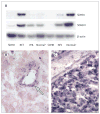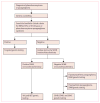An immunohistochemical procedure to detect patients with paraganglioma and phaeochromocytoma with germline SDHB, SDHC, or SDHD gene mutations: a retrospective and prospective analysis - PubMed (original) (raw)
Clinical Trial
doi: 10.1016/S1470-2045(09)70164-0. Epub 2009 Jul 1.
José Gaal, Judith Favier, Esther Korpershoek, Rogier A Oldenburg, Elly M C A de Bruyn, Hein F B M Sleddens, Pieter Derkx, Julie Rivière, Hilde Dannenberg, Bart-Jeroen Petri, Paul Komminoth, Karel Pacak, Wim C J Hop, Patrick J Pollard, Massimo Mannelli, Jean-Pierre Bayley, Aurel Perren, Stephan Niemann, Albert A Verhofstad, Adriaan P de Bruïne, Eamonn R Maher, Frédérique Tissier, Tchao Méatchi, Cécile Badoual, Jérôme Bertherat, Laurence Amar, Despoina Alataki, Eric Van Marck, Francesco Ferrau, Jerney François, Wouter W de Herder, Mark-Paul F M Vrancken Peeters, Anne van Linge, Jacques W M Lenders, Anne-Paule Gimenez-Roqueplo, Ronald R de Krijger, Winand N M Dinjens
Affiliations
- PMID: 19576851
- PMCID: PMC4718191
- DOI: 10.1016/S1470-2045(09)70164-0
Clinical Trial
An immunohistochemical procedure to detect patients with paraganglioma and phaeochromocytoma with germline SDHB, SDHC, or SDHD gene mutations: a retrospective and prospective analysis
Francien H van Nederveen et al. Lancet Oncol. 2009 Aug.
Abstract
Background: Phaeochromocytomas and paragangliomas are neuro-endocrine tumours that occur sporadically and in several hereditary tumour syndromes, including the phaeochromocytoma-paraganglioma syndrome. This syndrome is caused by germline mutations in succinate dehydrogenase B (SDHB), C (SDHC), or D (SDHD) genes. Clinically, the phaeochromocytoma-paraganglioma syndrome is often unrecognised, although 10-30% of apparently sporadic phaeochromocytomas and paragangliomas harbour germline SDH-gene mutations. Despite these figures, the screening of phaeochromocytomas and paragangliomas for mutations in the SDH genes to detect phaeochromocytoma-paraganglioma syndrome is rarely done because of time and financial constraints. We investigated whether SDHB immunohistochemistry could effectively discriminate between SDH-related and non-SDH-related phaeochromocytomas and paragangliomas in large retrospective and prospective tumour series.
Methods: Immunohistochemistry for SDHB was done on 220 tumours. Two retrospective series of 175 phaeochromocytomas and paragangliomas with known germline mutation status for phaeochromocytoma-susceptibility or paraganglioma-susceptibility genes were investigated. Additionally, a prospective series of 45 phaeochromocytomas and paragangliomas was investigated for SDHB immunostaining followed by SDHB, SDHC, and SDHD mutation testing.
Findings: SDHB protein expression was absent in all 102 phaeochromocytomas and paragangliomas with an SDHB, SDHC, or SDHD mutation, but was present in all 65 paraganglionic tumours related to multiple endocrine neoplasia type 2, von Hippel-Lindau disease, and neurofibromatosis type 1. 47 (89%) of the 53 phaeochromocytomas and paragangliomas with no syndromic germline mutation showed SDHB expression. The sensitivity and specificity of the SDHB immunohistochemistry to detect the presence of an SDH mutation in the prospective series were 100% (95% CI 87-100) and 84% (60-97), respectively.
Interpretation: Phaeochromocytoma-paraganglioma syndrome can be diagnosed reliably by an immunohistochemical procedure. SDHB, SDHC, and SDHD germline mutation testing is indicated only in patients with SDHB-negative tumours. SDHB immunohistochemistry on phaeochromocytomas and paragangliomas could improve the diagnosis of phaeochromocytoma-paraganglioma syndrome.
Funding: The Netherlands Organisation for Scientific Research, Dutch Cancer Society, Vanderes Foundation, Association pour la Recherche contre le Cancer, Institut National de la Santé et de la Recherche Médicale, and a PHRC grant COMETE 3 for the COMETE network.
Conflict of interest statement
Conflicts of interest
The authors declared no conflicts of interest.
Figures
Figure 1. SDHB immunohistochemistry
Phaeochromocytoma and paraganglioma SDHB immunohistochemistry. (A) Phaeochromocytoma with SDHB mutation. (B) Paraganglioma with SDHC mutation. (C) Paraganglioma with SDHD mutation. (D) Phaeochromocytoma with VHL mutation. (E) Phaeochromocytoma with RET mutation. (F) Phaeochromocytoma from a patients with NF1 (clinical diagnosis). Note: Strong speckled SDHB immunostaining in non-SDH mutated tumours (D, E, and F). Absence of SDHB immunostaining in the tumour cells of SDHB, SDHC, and _SDHD-_mutated tumours, with positive staining in the normal cells of the intratumoral fibrovascular network (A, B, and C). In the _SDHD-_mutated tumour (C) diffuse cytoplasmic background staining is seen, clearly distinct from the staining of the intratumoral fibrovascular network.
Figure 2. Western blotting and enzyme histochemical results
(A) Western blot result with SDHB antibodies from Novus Biologicals NB600-1366 (SDHB I) and Sigma HPA002868 (SDHB II) and β-actin of phaeochromocytoma with different mutations. SDHB case: SDHB exon 3 deletion; SDHD case: SDHD p.Asp92Tyr missense mutation; RET case: RET p.Cys634Arg missense mutation; VHL case: VHL p.Arg64Pro missense mutation; NF1 case: clinically defined NF1. *Normal is a lysate from a lymph node from the patient with the SDHB mutation. †Normal is a lysate from a healthy adrenal gland. SDH-enzyme histochemistry results: (B) loss of SDH activity in tumour cells of a phaeochromocytoma with a SDHD p.Asp92Tyr mutation, but retained activity in the normal cells of the intratumoral fibrovascular network (arrow); (C) strong SDH activity in tumour and normal cells of a phaeochromocytoma with a RET p.Cys634Arg mutation.
Figure 3. Suggested algorithm for molecular genetic testing for phaeochromocytoma and paraganglioma
The presence of familial or clinical criteria for a phaeochromocytoma-associated or paraganglioma-associated inherited disease should lead to targeted genetic testing. In the absence of criteria, SDHB immunohistochemistry is indicated. A positive SDHB immunohistochemistry result should lead to VHL and RET genetic testing, a negative SDHB immunohistochemistry should lead to SDH (SDHD, SDHB, and SDHC) genetic testing, starting with SDHD in cases of head and neck paraganglioma or starting with SDHB in cases of thoracic–abdominal or pelvic paraganglioma.
Comment in
- Diagnosing patients with hereditary paraganglial tumours.
Erlic Z, Neumann HP. Erlic Z, et al. Lancet Oncol. 2009 Aug;10(8):741. doi: 10.1016/S1470-2045(09)70204-9. Lancet Oncol. 2009. PMID: 19647193 Review. No abstract available.
Similar articles
- Potential Pitfalls of SDH Immunohistochemical Detection in Paragangliomas and Phaeochromocytomas Harbouring Germline SDHx Gene Mutation.
Santi R, Rapizzi E, Canu L, Ercolino T, Baroni G, Fucci R, Costa G, Mannelli M, Nesi G. Santi R, et al. Anticancer Res. 2017 Feb;37(2):805-812. doi: 10.21873/anticanres.11381. Anticancer Res. 2017. PMID: 28179334 - Novel succinate dehydrogenase subunit B (SDHB) mutations in familial phaeochromocytomas and paragangliomas, but an absence of somatic SDHB mutations in sporadic phaeochromocytomas.
Benn DE, Croxson MS, Tucker K, Bambach CP, Richardson AL, Delbridge L, Pullan PT, Hammond J, Marsh DJ, Robinson BG. Benn DE, et al. Oncogene. 2003 Mar 6;22(9):1358-64. doi: 10.1038/sj.onc.1206300. Oncogene. 2003. PMID: 12618761 - SDH mutations in tumorigenesis and inherited endocrine tumours: lesson from the phaeochromocytoma-paraganglioma syndromes.
Pasini B, Stratakis CA. Pasini B, et al. J Intern Med. 2009 Jul;266(1):19-42. doi: 10.1111/j.1365-2796.2009.02111.x. J Intern Med. 2009. PMID: 19522823 Free PMC article. Review. - Tumour risks and genotype-phenotype correlations associated with germline variants in succinate dehydrogenase subunit genes SDHB, SDHC and SDHD.
Andrews KA, Ascher DB, Pires DEV, Barnes DR, Vialard L, Casey RT, Bradshaw N, Adlard J, Aylwin S, Brennan P, Brewer C, Cole T, Cook JA, Davidson R, Donaldson A, Fryer A, Greenhalgh L, Hodgson SV, Irving R, Lalloo F, McConachie M, McConnell VPM, Morrison PJ, Murday V, Park SM, Simpson HL, Snape K, Stewart S, Tomkins SE, Wallis Y, Izatt L, Goudie D, Lindsay RS, Perry CG, Woodward ER, Antoniou AC, Maher ER. Andrews KA, et al. J Med Genet. 2018 Jun;55(6):384-394. doi: 10.1136/jmedgenet-2017-105127. Epub 2018 Jan 31. J Med Genet. 2018. PMID: 29386252 Free PMC article. - Familial paraganglioma syndromes.
Chetty R. Chetty R. J Clin Pathol. 2010 Jun;63(6):488-91. doi: 10.1136/jcp.2010.076257. J Clin Pathol. 2010. PMID: 20498024 Review.
Cited by
- Genetic stratification of inherited and sporadic phaeochromocytoma and paraganglioma: implications for precision medicine.
Casey R, Neumann HPH, Maher ER. Casey R, et al. Hum Mol Genet. 2020 Oct 20;29(R2):R128-R137. doi: 10.1093/hmg/ddaa201. Hum Mol Genet. 2020. PMID: 33059362 Free PMC article. Review. - Oxygen concentration controls epigenetic effects in models of familial paraganglioma.
Her YF, Nelson-Holte M, Maher LJ 3rd. Her YF, et al. PLoS One. 2015 May 18;10(5):e0127471. doi: 10.1371/journal.pone.0127471. eCollection 2015. PLoS One. 2015. PMID: 25985299 Free PMC article. - Germline SDHB and SDHD mutations in pheochromocytoma and paraganglioma patients.
Huang Y, Wang LA, Xie Q, Pang J, Wang L, Yi Y, Zhang J, Zhang Y, Chen R, Lan W, Zhang D, Jiang J. Huang Y, et al. Endocr Connect. 2018 Dec 1;7(12):1217-1225. doi: 10.1530/EC-18-0325. Endocr Connect. 2018. PMID: 30352407 Free PMC article. - Genetic testing for pheochromocytoma.
Karasek D, Frysak Z, Pacak K. Karasek D, et al. Curr Hypertens Rep. 2010 Dec;12(6):456-64. doi: 10.1007/s11906-010-0151-1. Curr Hypertens Rep. 2010. PMID: 20938758 Free PMC article. Review. - Genetic Profile of Indian Pheochromocytoma and Paraganglioma Patients - A Single Institutional Study.
Agarwal G, Rajan S, Valiveru RC, Tulsyan S, Agrawal V, Mittal B, Zaidi G, Mayilvaganan S, Mishra A, Agarwal A, Mishra SK, Bhatia E. Agarwal G, et al. Indian J Endocrinol Metab. 2019 Jul-Aug;23(4):486-490. doi: 10.4103/ijem.IJEM_163_19. Indian J Endocrinol Metab. 2019. PMID: 31741911 Free PMC article.
References
- Lenders JW, Eisenhofer G, Mannelli M, Pacak K. Phaeochromocytoma. Lancet. 2005;366:665–75. - PubMed
- Karagiannis A, Mikhailidis DP, Athyros VG, Harsoulis F. Phaeochromocytoma: an update on genetics and management. Endocr Relat Cancer. 2007;14:935–56. - PubMed
- Nakamura E, Kaelin WG., Jr Recent insights into the molecular pathogenesis of phaeochromocytoma and paraganglioma. Endocr Pathol. 2006;17:97–106. - PubMed
- Amar L, Bertherat J, Baudin E, et al. Genetic testing in phaeochromocytoma or functional paraganglioma. J Clin Oncol. 2005;23:8812–18. - PubMed
- Lancaster CR. Succinate:quinone oxidoreductases: an overview. Biochim Biophys Acta. 2002;1553:1–6. - PubMed
Publication types
MeSH terms
Substances
LinkOut - more resources
Full Text Sources
Other Literature Sources
Medical
Research Materials


